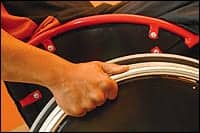Two studies presented during the recent Association of Academic Physiatrists Annual Meeting in Sacramento, Calif, highlight what may be benefits of wearing a robotic exoskeleton.
In the first study, researchers from The University of Texas Health Science Center at Houston (UTHealth), TIRR Memorial Hermann, and Texas Women’s University suggest that walking with a robotic exoskeleton may help enable people with multiple sclerosis to walk more efficiently by reducing the energy and muscle activity needed to walk.
During the study, a 33-year-old female with MS received 12 training sessions in exoskeleton-assisted walking. At the end of her training, she performed a timed up-and-go test, a 25-foot walking test at both a self-selected and fast pace, and a 6-minute walk. During the tests, the researchers assessed the amount of energy expended as well as the muscle activity in both the upper and lower body. These results were then compared to results of the same tests completed at the end of the study without the exoskeleton, explains a media release from the Association of Academic Physiatrists.
“Wearable exoskeletons offer the feasibility of assisted overground walking and may be effective assistance devices to promote efficient walking, and better quality of life,” says the study’s lead investigator Shuo-Hsiu “James” Chang, assistant professor at UTHealth, Neurorecovery Research Center at TIRR Memorial Hermann, in the release.
He notes that the wearable exoskeleton could be one of the advanced technologies that could further promote effectiveness of rehabilitation strategies.
In the second study, researchers suggest that motor skill training using a robotic arm exoskeleton may be beneficial to people experiencing post-stroke weakness affecting an entire side of their body, per the release.
An upper limb robotic exoskeleton called the CAREX was used to compare the extent of motor learning in people with post-stroke hemiparesis to people who have not had a stroke. The researchers also looked at whether use of this device would be more or less effective at different stages of stroke recovery.
Using the CAREX exoskeleton, which consists of three lightweight cuffs—one on the shoulder, one on the arm, and one on the forearm—attached to motor-controlled cables, the researchers evaluated 14 individuals (19 entered the study and 14 completed it) who had chronic post-stroke right hemiparesis and compared them to seven people who had not had a stroke while they performed three sets of circle drawing exercises, the release explains.
“We found that higher-functioning patients, those who had muscle strength but not control, benefited from the path-assistance provided by the robot. Whereas lower-functioning patients did worse when path assistance was provided. They did better, however, when the arm was supported by the robot,” says the study’s lead investigator Syed Zain Ali, a second-year medical student at New York Institute of Technology’s College of Osteopathic Medicine, in the release.
[Source(s): Association of Academic Physiatrists, Newswise]




